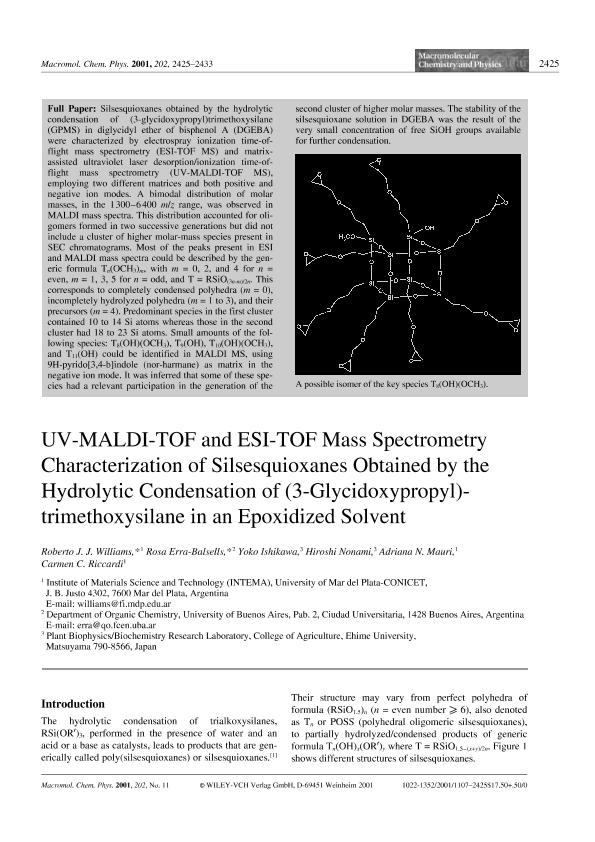Artículo
UV-MALDI-TOF and ESI-TOF Mass Spectrometry Characterization of Silsesquioxanes Obtained by the Hydrolytic Condensation of (3-Glycidoxypropyl)- trimethoxysilane in an Epoxidized Solvent
Williams, Roberto Juan Jose ; Erra Balsells, Rosa
; Erra Balsells, Rosa ; Ishikawa, Yoko; Nonami, Hiroshi; Mauri, Adriana Noemi
; Ishikawa, Yoko; Nonami, Hiroshi; Mauri, Adriana Noemi ; Riccardi, Carmen Cristina
; Riccardi, Carmen Cristina
 ; Erra Balsells, Rosa
; Erra Balsells, Rosa ; Ishikawa, Yoko; Nonami, Hiroshi; Mauri, Adriana Noemi
; Ishikawa, Yoko; Nonami, Hiroshi; Mauri, Adriana Noemi ; Riccardi, Carmen Cristina
; Riccardi, Carmen Cristina
Fecha de publicación:
01/07/2001
Editorial:
Wiley VCH Verlag
Revista:
Macromolecular Chemistry And Physics
ISSN:
1022-1352
Idioma:
Inglés
Tipo de recurso:
Artículo publicado
Clasificación temática:
Resumen
Silsesquioxanes obtained by the hydrolytic condensation of (3-glycidoxypropyl)trimethoxysilane (GPMS) in diglycidyl ether of bisphenol A (DGEBA) were characterized by electrospray ionization time-of-flight mass spectrometry (ESI-TOF MS) and matrix-assisted ultraviolet laser desorption/ionization time-of-flight mass spectrometry (UV-MALDI-TOF MS), employing two different matrices and both positive and negative ion modes. A bimodal distribution of molar masses, in the 1 300?6 400 m/z range, was observed in MALDI mass spectra. This distribution accounted for oligomers formed in two successive generations but did not include a cluster of higher molar-mass species present in SEC chromatograms. Most of the peaks present in ESI and MALDI mass spectra could be described by the generic formula Tn(OCH3)m, with m = 0, 2, and 4 for n = even, m = 1, 3, 5 for n = odd, and T = RSiO(3n-m)/2n. This corresponds to completely condensed polyhedra (m = 0), incompletely hydrolyzed polyhedra (m = 1 to 3), and their precursors (m = 4). Predominant species in the first cluster contained 10 to 14 Si atoms whereas those in the second cluster had 18 to 23 Si atoms. Small amounts of the following species: T8(OH)(OCH3), T9(OH), T10(OH)(OCH3), and T11(OH) could be identified in MALDI MS, using 9H-pyrido[3,4-b]indole (nor-harmane) as matrix in the negative ion mode. It was inferred that some of these species had a relevant participation in the generation of the second cluster of higher molar masses. The stability of the silsesquioxane solution in DGEBA was the result of the very small concentration of free SiOH groups available for further condensation.
Palabras clave:
Silsesquioxanes
,
Hydrolytic Condensation
,
Epoxidized Solvent
,
Uv-Maldi-Tof
Archivos asociados
Licencia
Identificadores
Colecciones
Articulos(INTEMA)
Articulos de INST.DE INV.EN CIENCIA Y TECNOL.MATERIALES (I)
Articulos de INST.DE INV.EN CIENCIA Y TECNOL.MATERIALES (I)
Citación
Williams, Roberto Juan Jose; Erra Balsells, Rosa; Ishikawa, Yoko; Nonami, Hiroshi; Mauri, Adriana Noemi; et al.; UV-MALDI-TOF and ESI-TOF Mass Spectrometry Characterization of Silsesquioxanes Obtained by the Hydrolytic Condensation of (3-Glycidoxypropyl)- trimethoxysilane in an Epoxidized Solvent; Wiley VCH Verlag; Macromolecular Chemistry And Physics; 202; 11; 1-7-2001; 2425-2433
Compartir
Altmétricas



